(Press-News.org) People are able to detect, within a split second, if a hurtful action they are witnessing is intentional or accidental, new research on the brain at the University of Chicago shows.
The study is the first to explain how the brain is hard-wired to recognize when another person is being intentionally harmed. It also provides new insights into how such recognition is connected with emotion and morality, said lead author Jean Decety, the Irving B. Harris Professor of Psychology and Psychiatry at UChicago.
"Our data strongly support the notion that determining intentionality is the first step in moral computations," said Decety, who conducted research on the topic with Stephanie Cacioppo, a research associate (assistant professor) in psychology at UChicago. They published the results in a paper, "The Speed of Morality: A High-Density Electrical Neuroimaging Study," to be published Dec. 1 and now on early preview in the Journal of Neurophysiology.
The researchers studied adults who watched videos of people who suffered accidental harm (such as being hit with a golf club) and intentional harm (such as being struck with a baseball bat). While watching the videos, brain activity was collected with equipment that accurately maps responses in different regions of the brain and importantly, the timing between these regions. The technique is known as high-density, event-related potentials technology.
The intentional harm sequence produced a response in the brain almost instantly. The study showed that within 60 milliseconds, the right posterior superior temporal sulcus (also known as TPJ area), located in the back of the brain, was first activated, with different activity depending on whether the harm was intentional or accidental. It was followed in quick succession by the amygdala, often linked with emotion, and the ventromedial prefrontal cortex (180 milliseconds), the portion of the brain that plays a critical role in moral decision-making.
There was no such response in the amygdala and ventromedial prefrontal cortex when the harm was accidental.
Other studies with functional MRI scans, including those in Decety's lab, have shown that those areas of the brain become activated when people see others intentionally harmed, but those studies have been unable to separate or time the way the various parts of the brain may work together.
"High-density ERPs can identify spatio-temporal patterns of communication between regions that contrast analyses (such as fMRI) with low temporal resolution may not detect, and such methods are necessary to advance knowledge of neuroscience of morality," said Cacioppo.
The ability to recognize and respond emotionally to the intentional infliction of harm is a critical source of morality that is universal across cultures, researchers believe. "It is part of humans' evolutionary heritage," Decety said. "The long history of mammalian evolution has shaped our brains to be sensitive to signs of suffering of others. And this constitutes a natural foundation for morality and sensitivity to justice."
Philosophers have debated the origins of this moral response for ages. Some maintain that moral judgments begin with an immediate aversive reaction to perceived or imagined harm to victims, though the full moral judgment may form only after the fact. Other philosophers maintain that moral principals develop from reason alone and are not connected to emotion.
The new research suggests that emotion and the perception of intentionality, rather than deliberate reasoning, comprise the vital first component of moral responses—at least for responses that stem from care for others Decety said.
The research may help inform other areas of neurodevelopment research, including studies of the moral responses of psychopaths and of children who lack empathy for others, displaying what are called callous-unemotional traits.
###
The National Science Foundation and the Swiss National Science Foundation supported the research.
Moral evaluations of harm are instant and emotional, brain study shows
2012-11-29
ELSE PRESS RELEASES FROM THIS DATE:
Rules devised for building ideal protein molecules from scratch
2012-11-29
By following certain rules, scientists can prepare architectural plans for building ideal protein molecules not found in the real world. Based on these computer renditions, previously non-existent proteins can be produced from scratch in the lab. The principles to make this happen appear this month in Nature magazine.
The lead authors are Dr. Nobuyasu Koga and Dr. Rie Tatsumi-Koga, a husband-and-wife scientific team in Dr. David Baker's lab at the University of Washington Protein Design Institute.
The project benefited from hundreds of thousands of computer enthusiasts ...
Most of the harmful mutations in people arose in the past 5,000 to 10,000 years
2012-11-29
A study dating the age of more than 1 million single-letter variations in the human DNA code reveals that most of these mutations are of recent origin, evolutionarily speaking. These kinds of mutations change one nucleotide – an A, C, T or G – in the DNA sequence. Over 86 percent of the harmful protein-coding mutations of this type arose in humans just during the past 5,000 to 10,000 years.
Some of the remaining mutations of this nature may have no effect on people, and a few might be beneficial, according to the project researchers. While each specific mutation is ...
Alcoholic fly larvae need fix for learning
2012-11-29
Fly larvae fed on alcohol-spiked food for a period of days grow dependent on those spirits for learning. The findings, reported in Current Biology, a Cell Press publication, on November 29th, show how overuse of alcohol can produce lasting changes in the brain, even after alcohol abuse stops.
The report also provides evidence that the very human experience of alcoholism can be explored in part with studies conducted in fruit flies and other animals, the researchers say.
"Our evidence supports the long-ago proposed idea that functional ethanol tolerance is produced by ...
Hand use improved after spinal cord injury with noninvasive stimulation
2012-11-29
By using noninvasive stimulation, researchers were able to temporarily improve the ability of people with spinal cord injuries to use their hands. The findings, reported on November 29th in Current Biology, a Cell Press publication, hold promise in treating thousands of people in the United States alone who are partially paralyzed due to spinal cord injury.
"This approach builds on earlier work and highlights the importance of the corticospinal tract—which conducts impulses from the brain's motor cortex to the spinal cord and is a major pathway contributing to voluntary ...
Traffic cops of the immune system
2012-11-29
This press release is available in German.
Now, scientists at the Helmholtz Centre for Infection Research (HZI) have looked into the origin of Tregs and uncovered a central role played by the protein IkBNS. Armed with this knowledge, the researchers hope to manipulate Tregs in order to either inhibit or activate the immune system. Biochemist Prof. Ingo Schmitz and his team have now published their findings in the scientific journal Immunity.
The immune system is a complex network of different types of cells and chemical messengers. The regulatory cells and other immune ...
UW-Madison scientists create roadmap to metabolic reprogramming for aging
2012-11-29
MADISON – In efforts to understand what influences life span, cancer and aging, scientists are building roadmaps to navigate and learn about cells at the molecular level.
To survey previously uncharted territory, a team of researchers at UW-Madison created an "atlas" that maps more than 1,500 unique landmarks within mitochondria that could provide clues to the metabolic connections between caloric restriction and aging.
The map, as well as the techniques used to create it, could lead to a better understanding of how cell metabolism is re-wired in some cancers, age-related ...
Study helps resolve debate about how tumors spread
2012-11-29
A team of scientists, led by researchers at the University of California, San Diego School of Medicine, has shown for the first time how cancer cells control the ON/OFF switch of a program used by developing embryos to effectively metastasize in vivo, breaking free and spreading to other parts of the body, where they can proliferate and grow into secondary tumors.
The findings are published in the December 11 issue of the journal Cancer Cell.
In 90 percent of cancer deaths, it is the spreading of cancer, known as metastasis, which ultimately kills the patient by impacting ...
Study sheds light on how pancreatic cancer begins
2012-11-29
A diagnosis of pancreatic cancer is particularly devastating since the prognosis for recovery is usually poor, with the cancer most often not detected until late stages.
Research led by scientists at the University of California, San Diego and UC San Francisco Schools of Medicine examined the tumor-initiating events leading to pancreatic cancer (also called pancreatic ductal adenocarcinoma or PDA) in mice. Their work, published on line November 29 in the journal Cancer Cell, may help in the search for earlier detection methods and treatments.
"Previously, it was believed ...
Short-term exposure to essential oils lowers blood pressure and heart rate
2012-11-29
The scents which permeate our health spas from aromatic essential oils may provide more benefits than just a sense of rest and well-being.
For according to a new study(1) in the European Journal of Preventive Cardiology, the essential oils which form the basis of aromatherapy for stress relief are also reported to have a beneficial effect on heart rate and blood pressure following short-term exposure - and may therefore reduce the risk of cardiovascular disease. However, on the downside, those beneficial effects were reversed when exposure to essential oils lasted more ...
Prenatal exposure to testosterone leads to verbal aggressive behavior
2012-11-29
Washington, DC (November 27, 2012) –A new study in the Journal of Communication links verbal aggression to prenatal testosterone exposure. The lead researcher, at University at Buffalo – The State University of New York, used the 2D:4D measure to predict verbal aggression. This study is the first to use this method to examine prenatal testosterone exposure as a determinant of a communication trait.
Allison Z. Shaw, University at Buffalo – The State University of New York, Michael R. Kotowski, University of Tennessee, and Franklin J. Boster and Timothy R. Levine, Michigan ...





